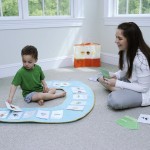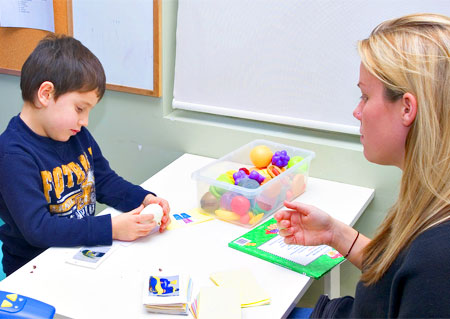Parents are often trained in ABA therapy, and several single-subject studies have shown that parental training helps children with autism who receive ABA therapy. Larger controlled studies looking at this issue are underway. Studies of parental satisfaction with ABA indicate that parents believe the approach is effective. Parents also report that they experience less stress as a result of applying ABA.
 Support is growing for increased use of ABA in the classroom. One study found that ABA therapy was as effective, and sometimes more effective, than other special education intervention programs. High-intensity ABA therapy (for example, the Lovaas method) during preschool can be more effective than special education techniques.
Support is growing for increased use of ABA in the classroom. One study found that ABA therapy was as effective, and sometimes more effective, than other special education intervention programs. High-intensity ABA therapy (for example, the Lovaas method) during preschool can be more effective than special education techniques.
There are, however, some controversies surrounding the ABA approach. Early ABA practice (in the 1980s and early 1990s) included the use of aversive techniques such as yelling at or restraining a child. Most ABA practitioners no longer consider aversive techniques to be acceptable, and the current ABA approach is equally effective without these techniques.
Experts also disagree as to whether the ABA approach should be used alone or along with other treatment methods. While there are varied opinions, most practitioners agree upon the importance of early intervention, intensive treatment for as much time as possible each day (in the range of 25 to 40 hours per week), well-trained practitioners, and consistent application of the ABA approach within and outside of school.
A crucial element of the ABA approach that is especially important for children with autism is finding appropriate reinforcement for each child. Because praise may not be rewarding for these children, careful analysis of each child’s behavior can help reveal more effective reinforcement tools. Examples of successful reinforcers may include access to a favorite toy or chair.
Is it harmful?
 There are no known negative effects of the ABA approach. This is especially the case if gentle prompting is used rather than aversive techniques.
There are no known negative effects of the ABA approach. This is especially the case if gentle prompting is used rather than aversive techniques.
Cost
Although autism is a condition covered under the Individuals with Disabilities Education Act (IDEA) of 2004, whether IDEA covers intensive ABA treatment is still being considered by the courts. For legal information about IDEA, go to http://www.wrightslaw.com/.
In order to effectively implement ABA, both parents and other major caretakers are usually trained in ABA. Workshops covering the basics of ABA treatment can last from 2 to 7 days, and cost between $175 to $1,000 per person. Online ABA courses are especially useful for parents who do not live in a large city.
Children can also be enrolled in schools and clinics that specialize in ABA treatment. These can be found in most major cities and university towns. The cost of such schools can be quite high; tuition ranges from $16,000 to $25,000 per year. However, some schools offer scholarships to parents in need.
It is possible to set up ABA treatment at home using therapists in training or college students who have taken a workshop in the ABA approach. This can also be expensive ($5,000 to $20,000/year), and requires a great deal of time organizing and structuring the program.
A qualified, full-time (30 hours/week or more) ABA therapist devoted to your child costs approximately $30,000 to $50,000 per year. Because of the success of ABA and the evidence indicating that training should be intensive (25 to 40 hours/week), there is very high demand for ABA-trained therapists, and it may be difficult to find one who is available.
Resources
 Healing Thresholds has partnered with Rethink Autism. Rethink Autism offers a Web-based autism treatment program that is based upon ABA. It makes ABA treatment accessible to many people who would otherwise have no access to ABA.
Healing Thresholds has partnered with Rethink Autism. Rethink Autism offers a Web-based autism treatment program that is based upon ABA. It makes ABA treatment accessible to many people who would otherwise have no access to ABA.
Healing Thresholds has also partnered with Natural Learning Concepts. They have many tools that will make it easier to do an ABA program in your own home.
Autism is a condition covered under the IDEA of 2004. Services covered by IDEA include early identification and assessment by an occupational therapist. This law protects the rights of patients with autism and provides guidelines to assist in their education. It covers children from birth to age 21 (U.S. Department of Education).
Pediatricians can provide contact information for the state early intervention program (for children 0 to 3 years old). School districts can coordinate special services for children 3 to 21 years old. For some additional coverage information in the U.S. go to: http://www.asha.org/public/coverage/autism.htm. In addition, there is a listing on this Web site for state early intervention centers.
Several books that might be useful:
Applied Behaviour Analysis And Autism: Building a Future Together by M. Keenan, M. Henderson, K.P. Kerr, and K Dillenburger (Eds.). 2005. Jessica Kingsley Publishers.
Understanding Applied Behavior Anaylsis: An Introduction to ABA for Parents, Teachers, and Other Professionals by A.J. Kearney. 2007. Jessica Kingsley Publishers.
The Verbal Behavior Approach: How to Teach Children with Autism and Related Disorders [VERBAL BEHAVIOR APPROACH -OS] by M. Barbera and T. Rasmussen. 2007. Jessica Kingsley Publishers.
Psychosocial Treatments For Child And Adolescent Disorders: Empirically Based Strategies For Clinical Practice (2nd Edition) by E. D. Hibbs & P. S. Jensen (Eds.). 2005. American Psychological Association.
Applied Behavior Analysis (2nd Edition) by J.O. Cooper, T.E. Heron, and W.L. Heward. 2007. Prentice Hall.
